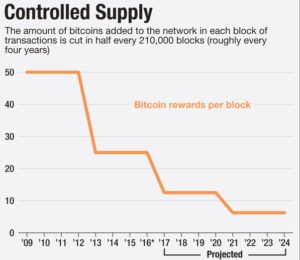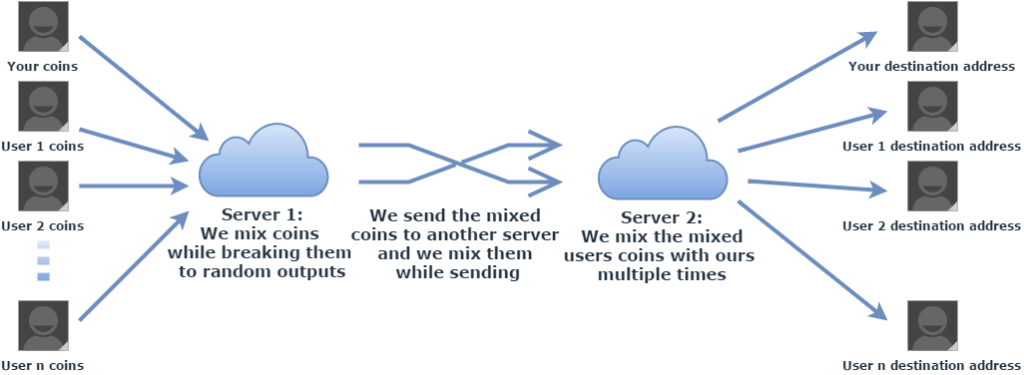CenturyLink is buying Level 3 in a transaction valued at $34 billion; the combined company will boast 450,000 route miles of fiber.



When it comes to the placement of interior lighting, much of the thought involved tends to relate to reaching nearby outlets. But the latest lights Toronto-based Nanoleaf may end up providing creative individuals one extra element to puzzle over. The Nanoleaf Aurora Smarter Kit is designed to be a modular lighting solution, featuring WiFi-controlled, color-adjustable, triangular panels that snap together like Lego.

By now, most Bitcoin and Blockchain enthusiasts are aware of four looming issues that threaten the conversion of Bitcoin from an instrument of academics, criminal activity, and closed circle communities into a broader instrument that is fungible, private, stable, ubiquitous and recognized as a currency—and not just an investment unit or a transaction instrument.
These are the elephants in the room:
As an Op-Ed pundit, I value original content. But the article, below, on Bitcoin fungibility, and this one on the post-incentive era, are a well-deserved nod to inspired thinking by other writers on issues that loom over the cryptocurrency community.
This article at Coinidol comes from an unlikely source: Jacob Okonya is a graduate student in Uganda. He is highly articulate, has a keen sense of market economics and the evolution of technology adoption. He is also a quick study and a budding columnist.
What Happens When Bitcoin Mining Rewards Diminish To Zero?
Jacob addresses this last issue with clarity and focus. I urge Wild Ducks to read it. My response, below touches on both issues 3 and 4 in the impromptu list, above.
Sunset mining incentives—and also the absence of supporting fully anonymous transactions—are two serious deficiencies in Bitcoin today.
I am confident that both shortcomings will be successfully addressed and resolved.
Thoughts about Issues #3 and #4: [Disclosure] I sit on the board at CRYPSA and draft whitepapers and position statements.*
Blockchain Building: Dwindling Incentives
 Financial incentives for miners can be replaced by non-financial awards, such as recognition, governance, gaming, stakeholder lotteries, and exchange reputation points. I am barely scratching the surface. Others will come up with more creative ideas.
Financial incentives for miners can be replaced by non-financial awards, such as recognition, governance, gaming, stakeholder lotteries, and exchange reputation points. I am barely scratching the surface. Others will come up with more creative ideas.
Last year, at the 2015 MIT Bitcoin Expo, Keynote speaker Andreas Antonopoulos expressed confidence that Bitcoin will survive the sunset of miner incentives. He proposed some novel methods of ongoing validation incentives—most notably, a game theory replacement. Of course, another possibility is the use of very small transaction fees to continue financial incentives.
Personally, I doubt that direct financial incentives—in the form of microcash payments— will be needed. Ultimately, I envision an ecosystem in which everyone who uses Bitcoin to buy, sell, gift, trade, or invest will avoid fees while creating fluidity—by sharing the CPU burden. All users will validate at least one Blockchain transaction for every 5 transactions of their own.
Today, that burden is complex by design, because it reflects increasing competition to find a diminishing cache of unmined coins. But without that competition, the CPU overhead will be trivial. In fact, it seems likely that a validation mechanism could be built into every personal wallet and every mobile device app. The potential for massive crowd-sourced scrutiny has the added benefit of making the blockchain more robust: Trusted, speedy, and resistant to attack.
Transaction Privacy & Anonymity
Bitcoin’s lack of rock-solid, forensic-thwarting anonymity is a weak point that must ultimately be addressed. It’s not about helping criminals, it’s about liberty and freedoms. Detectives & forensic labs have classic methods of pursuing criminals. It is not our job to offer interlopers an identity, serial number and traceable event for every transaction.
Anonymity can come in one of three ways. Method #3 is least desirable:
 and earnest but misguided attempts to create a registry of ‘tainted’ coins.
and earnest but misguided attempts to create a registry of ‘tainted’ coins.That’s my opinion on the sunset of mining incentives and on transaction anonymity.
—What’s yours?
* Philip Raymond is co-chair of the Cryptocurrency Standards
Association. He was host and MC for the Bitcoin Event in New York.

I was pointed to this article by Jon Matonis, Founding Director, Bitcoin Foundation. I was sufficiently moved to highlight it here at Lifeboat Foundation, where I am a contributing writer.
On Fungibility, Bitcoin, Monero and ZCash … [backup]
This is among the best general introductions I have come across on traceability and the false illusion of privacy. The explanation of coin mixing provides and excellent, quick & brief overview.
Regarding transaction privacy, a few alt-coins provide enhanced immunity or deniability from forensic analysis. But if your bet is on Bitcoin (as it must be), the future is headed toward super-mixing and wallet trading by desgin and by default. Just as the big email providers haved added secure transit,
Bitcoin will eventually be fully randomized and anonymized per trade and even when assets are idle. It’s not about criminals; it’s about protecting business, government and individuals. It’s about liberty and our freedoms. [Continue below image]

The next section of the article explains the danger of losing fungibility due to transaction tracing and blacklisting. I can see only ONE case for this, and it requires a consensus and a hard fork (preferably a consensus of ALL stakeholders and not just miners). For example, when a great number of Etherium was stolen during the DAO meltdown.
My partner, Manny Perez, and I take opposing views of blacklisting coins based on their ‘tainted’ history (according to “The Man”, of course!). I believe that blacklists must ultimately be rendered moot by ubiquitous mixing, random transaction-circuit delays,  and multiple-transaction ‘washing’ (intentionally invoking a term that legislators and forensic investigators hate)—Manny feels that there should be a “Law and Order” list of tainted coins. Last year, our Pro-&-Con views were published side-by-side in this whitepaper.
and multiple-transaction ‘washing’ (intentionally invoking a term that legislators and forensic investigators hate)—Manny feels that there should be a “Law and Order” list of tainted coins. Last year, our Pro-&-Con views were published side-by-side in this whitepaper.
Finally, for Dogbert’s take on fungible, click here. I bought the domain fungible.net many years ago, and I still haven’t figured out what to do with it. Hence this Dilbert cartoon. smile
____________
Philip Raymond is co-chair of The Cryptocurrency Standards Association.
He also presents on privacy, anonymity, blind signaling & antiforensics.

I argued in my 2015 paper “Why it matters that you realize you’re in a Computer Simulation” that if our universe is indeed a computer simulation, then that particular discovery should be commonplace among the intelligent lifeforms throughout the universe. The simple calculus of it all being (a) if intelligence is in part equivalent to detecting the environment (b) the environment is a computer simulation © eventually nearly all intelligent lifeforms should discover that their environment is a computer simulation. I called this the Savvy Inevitability. In simple terms, if we’re really in a Matrix, we’re supposed to eventually figure that out.
Silicon Valley, tech culture, and most nerds the world over are familiar with the real world version of the question are we living in a Matrix? The paper that’s likely most frequently cited is Nick Bostrom’s Are you living in a Computer Simulation? Whether or not everyone agrees about certain simulation ideas, everyone does seem to have an opinion about them.
Recently, the Internet heated up over Elon Musk’s comments at a Vox event on hot tub musings of the simulation hypothesis. Even Bank of America published an analysis of the simulation hypothesis, and, according to Tad Friend in an October 10, 2016 article published in New Yorker, “two tech billionaires have gone so far as to secretly engage scientists to work on breaking us out of the simulation.”

I remember working on data transfer and experimental apps on the NET in 1990 to 1995. And, did it ever change during just those 5 years. I cannot even imagine 1969.
On October 29th, 1969, the internet got its start when the first host-to-host connection was made between UCLA and the Stanford Research Institute. See how much you know about the invention that would change the world with some trivia questions…

Get Ready Folks! Imagine a QC DarkNet as it will too come.
Quantum teleportation brings to mind Star Trek’s transporter, where crew members are disassembled in one location to be reassembled in another. Real quantum teleportation is a much more subtle effect where information is transferred between entangled quantum states. It’s a quantum trick that could give us the ultimate in secure communication. While quantum teleportation experiments have been performed countless times in the lab, doing it in the real world has proved a bit more challenging. But a recent experiment using a dark fibre portion of the internet has brought quantum teleportation one step closer to real world applications.
The backbone of the internet is a network of optical fibre. Everything from your bank transactions to pictures of your cat travel as beams of light through this fibre network. However there is much more fibre that has been laid than is currently used. This unused portion of the network is known as dark fibre. Other than not being currently used, the dark fiber network has the same properties as the web we currently use. This new experiment used a bit of this dark web in Calgary to teleport a photon state under real world conditions.
The basic process of quantum teleportation begins with two objects (in this case photons) that are quantumly entangled. This basically means the state of these two objects are connected in such a way that a measurement of one object affects the state of the other. For quantum teleportation, one of these entangled objects is measured in combination with the object to be “teleported” (another photon). The result of this measurement is then sent to the other location, where a similar combined measurement is made. Since the entangled objects are part of both measurements, quantum information can be “teleported.” This might seem like an awkward way to send information, but it makes for a great way to keep your messages secret. Using this method, Alice can basically encrypt a message using the entangled objects, send the encrypted message to Bob, who can then make his own measurement of the entangled state to decode the message.

Society is about to take another big step into the age of space-based manufacturing.
Early next year, California-based startup Made In Space plans to launch a machine to the International Space Station (ISS) that will produce ZBLAN optical fiber.
ZBLAN has the potential to be much more efficient than the silica-based fiber currently used in the internet and telecommunications industries, but it’s tough to make here on Earth because the planet’s strong gravitational pull induces imperfections in the ZBLAN crystal lattice, Made In Space representatives said. [3D Printing: 10 Ways It Could Transform Space Travel].

My new story for Vice Motherboard on lessons learned running for President as a transhumanist. It’s also my endorsement of a ranked voting system:
Campaigning in Times Square.
With such overwhelming odds against my candidacy and tiny political party from the start, I chose to bypass the battle to get on state ballots and instead focus using media to move the transhumanism movement ahead. After all, only very rarely have third parties in America affected the outcome of the elections anyway. Like it or not, you are stuck with an elephant or a donkey-headed leader.
The good news, though, is the internet is making a run for the presidency a good way to get attention for a cause like transhumanism. It may only take five minutes to file a candidacy form with the FEC to run for US president, but the legitimacy in many people’s minds is real. Some candidates out there are using this for real good for the country, like the Nutrition Party and its candidate Rod Silva, which is trying to improve the way America eats. Or the Marijuana Party, which wants to legalize pot and end the asinine War on Drugs.
I’ve been honored to watch transhumanism grow a lot under my candidacy. My main goal all along has been to tell the world that science and technological innovation is coming far more quickly than ever before, and as a nation, we must answer to it with practical and forward-thinking policies. If we don’t, it could lead to increased inequality, a blatantly dystopian future, and a severe planetary environmental crisis.

Elon Musk is obsessed with space. At age 30, he founded SpaceX. At age 41, he oversaw the first cargo mission to the International Space Station by a private company. And at age 12, as a kid living in South Africa, he made a space-themed PC game called Blastar. Now, thanks to the power of the internet, you can play that game.
Musk sold the code for Blastar for $500 to the magazine PC and Office Technology, and a reproduction of the page it appeared on was published in Ashlee Vance’s biography Elon Musk: Tesla, SpaceX, and the Quest for a Fantastic Future. From there, Tomas Lloret Llinares — a software engineer at Google — took the code and rebuilt the game to work in HTML5.
Your mission, as the game’s lonely space pilot, is to “destroy [the] alien freighter carrying deadly hydrogen bombs and status beam machines.” Blastar is mostly a mix of Space Invaders and Asteroid, though it’s much more basic. There is never more than two ships on the screen, there are few sound effects, and — like many games of its time — it really has no ending. It’s almost unimpressive; that is, until you remember that it was made by a 12-year-old in 1984.